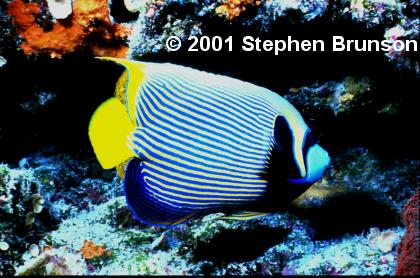








Emperor Angelfish: Pomacanthus imperator
Angelfish is a name used for several different fishes, including the true angelfishes, (Pomacanthidae) and the butterfly fishes (Chaetodontidae). Angelfishes differ from butterfly fishes in having a spine near the lower edge of the gill cover. These laterally compressed fishes are among the most beautiful of the tropical reef fishes. Most species are only a few centimeters long, but some grow to 24 inches. In many species the juveniles and adults are
colored differently. The young French angelfish is black with bright yellow bands; the adult is mainly black. The queen angelfish is also differently colored as a juvenile. Like many other Angelfish, the Emperor Angel Pomacanthus imperator feeds upon sponges, tunicates, algae, and small invertebrates.

Print Number - AF001
Limited Edition signed color photography for sale by Stephen Brunson
Emperor Angelfish, Pomacanthus imperator Statistics:
Size: 15 - 17 inches
Lifespan: Approximately 15 years.
Breeding: It appears that Emperor Angels mate for life; they scatter their eggs with the tide.
Habitat: Shallow coral reefs and walls in depths of 100 ft. or less.
Diet: Sponges, algae, and small invertebrates.
Distribution: Throughout the Pacific and Indian Oceans; From West Africa to Japan to Australia.
Habit: Active during the day and often lethargic at night. Very aggressive and territorial.
BrunsonImages@att.net


















